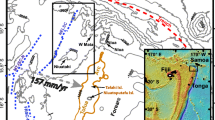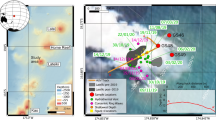Abstract
Lava flowing into a pit crater will become entrapped to form an inactive lava lake. At Masaya volcano (Nicaragua) pit filling lavas are exposed in the walls of Nindiri, Santiago and San Pedro pits. Mapping of these lavas shows that fill can involve emplacement of both ’a’a and pahoehoe, with single fill units ranging in thickness from 2 to 22 m. Thick units with columnar joints were emplaced as simple inactive lava lakes during high effusion rate episodes. Sequences of thinner units, which can form pit floor shields or compound lakes, were emplaced at lower effusion rates. Lava withdrawal caused unsupported sections of three 20-m-thick units to subside, resulting in unit flexure and faulting, and viscous peeling features reveal that subsidence occurred while at least one unit was still partially molten. Where withdrawal has not occurred, fill sequences are flat lying and symmetrically distributed around the feeder structures (cinder cones and dykes). The filled Nindiri pit holds 5 × 107 m3 of lava in a 215-m-thick sequence. Partial fill of Santiago pit with 1 × 107 m3 of lava has filled the pit with a 110-m-thick lava sequence, of which ∼50% has been consumed by formation of a secondary pit. Altogether, 6.4 × 107 m3 of lava was erupted into Nindiri and Santiago during 1525–1965, with 94% of this volume remaining pit-contained; the remainder forms a north flank lava flow field. Pit development and filling is a dynamic and ephemeral process, having short-lived effects on volcano morphology, where pits develop and fill over hours-to-centuries. However, pits play an important role in shaping an edifice, representing lava sinks and controlling whether lavas are trapped or able to spread onto the flanks.









Similar content being viewed by others
References
Brigham WT (1909) The volcanoes of Kilauea and Mauna Loa. Memoirs of the Bernice Pauahi Bishop Museum 2(4):1–608
Carter A, van Wyk de Vries B, Kelfoun K, Bachèlery P, Briole P (2007) Pits, rifts and slumps: the summit structure of Piton de la Fournaise. Bull Volcanol 69:741–756
Chester DK, Duncan AM, Guest JE, Kilburn CRJ (1985) Mount Etna: the anatomy of a volcano. Chapman & Hall, London
Clague DA, Hagstrum JT, Champion DE, Beeson MH (1999) Kilauea summit overflows: their ages and distribution in the Puna District, Hawai’i. Bull Volcanol 61:363–381
Dana JD (1891) Characteristics of volcanoes. Dodd, Mead and Company, New York
de Oviedo y Valdes GF (1855) General and natural history of the Indias. Jose de los Rios, Madrid, Part 3 4:70–92
Dutton CE (1884) Hawaiian volcanoes. 4th Annual Report of the US Geol Surv, pp 75–219
Hitchcock CH (1909) Hawaii and its volcanoes. The Hawaiian Gazette Company, Honolulu
Holcomb RT (1987) Eruptive history and long-term behavior of Kilauea volcano. US Geol Surv Prof Pap 1350:261–350
Holland M, Urai JL, Martel S (2006) The internal structure of fault zones in basaltic sequences. Earth Planet Sci Lett 248:286–300
Jackson DB, Swanson DA, Koyanagi RY, Wright TL (1975) The August and October 1968 East Rift eruptions of Kilauea Volcano, Hawaii. US Geol Surv Prof Pap 890:1–33
Jaggar TA (1947) Origin and development of craters. Geol Soc Am Mem 21:1–508
Jeffreys H (1925) Flow of water in an inclined channel of rectangular section. Philos Mag J Sci 49:793–807
Kaven JO, Martel SJ (2007) Growth of surface-breaching normal faults as a three-dimensional fracturing process. J Struct Geol 29:1463–1476
Maciejewski AJH (1998) Remote measurements of volcanic gases: applications of open-path Fourier transform infrared-spectroscopy (OP-FTIR) and correlation spectroscopy (COSPEC). PhD thesis, The Open University, Milton Keynes
Marsh BD (1981) On the crystallinity, probability of occurrence, and rheology of lava and magma. Contrib Mineral Petrol 78:85–98
Martel SJ, Langley JS (2006) Propagation of normal faults to the surface in basalt, Koae fault system, Hawaii. J Struct Geol 28:2123–2143
McBirney AR (1956) The Nicaraguan volcano Masaya and its caldera. EOS Trans Am Geophys Union 37(1):83–96
Montessus de Ballore F (1888) Tremblements de terre et eruptions volcaniques en center amerique depuis la coquette espagnole fusqu`a nos tours. Societe Sciences Naturelles De Saoreet-Loire, Dijon, p 293
Nichols RL (1938) Grooved lava. J Geol 46:601–614
Nichols RL (1939) Surficial banding and shark’s-tooth projections in the cracks of basaltic lava. Am J Sci 237:188–194
Nichols RL, Stearns CE (1939) Grooved lava in the cross-section of Big Craters, Idaho. Am J Sci 237:22–31
Peck DL (1978) Cooling and vesiculation of Alae lava lake, Hawaii. US Geol Surv Prof Pap 935-B:1–59
Peck DL, Minakami T (1968) The formation of columnar joints in the upper part of Kilauean lava lakes, Hawaii. Geol Soc Am Bull 79:1151–1166
Peck DL, Wright TL, Moore JG (1966) Crystallization of tholeiitic basalt in Alae lava lake, Hawaii. Bull Volcanol 29:487–498
Richter DH, Eaton JP, Murata KJ, Ault WU, Krivoy HL (1970) Chronological narrative of the 1959–60 eruption of Kilauea volcano, Hawaii. US Geol Surv Prof Pap 537-E:1–73
Rittmann A (1962) Volcanoes and their activity. Wiley, New York
Roche O, Druitt TH, Merle O (2000) Experimental study of caldera formation. J Geophys Res 105:395–416
Roche O, van Wyk de Vries B, Druitt TH (2001) Sub-surface structures and collapse mechanisms of summit pit craters. J Volcanol Geotherm Res 105:1–18
Rymer H, van Wyk de Vries B, Stix J, Williams-Jones G (1998) Pit crater structure and processes governing persistent activity at Masaya Volcano, Nicaragua. Bull Volcanol 59:345–355
Shaw HR (1972) Viscosities of magmatic silicate liquids: an empirical method of prediction. Am J Sci 272:870–893
Stearns HT, Clark WO (1930) Geology and water resources of the Kau district, Hawaii. Water Supply Paper 616:1–194
Stoiber RE, Williams SN, Huebert BJ (1986) Sulfur and halogen gases at Masaya caldera complex, Nicaragua: total flux and variations with time. J Geophys Res 91:12215–12231
Swanson DA, Peterson DW (1972) Partial draining of Alae lava lake and the resulting crustal subsidence. USGS Prof Pap 800-C:1–14
Swanson DA, Duffield WA, Jackson DB, Peterson DW (1972) The complex filling of Alae crater, Kilauea volcano, Hawaii. Bull Volcanol 36:105–126
Swanson DA, Duffield WA, Jackson DB, Peterson DW (1979) Chronological narrative of the 1969–71 Mauna Ulu eruption of Kilauea Volcano, Hawaii. US Geol Surv Prof Pap 1056:1–55
Tilling RI, Christansen RL, Duffield WA, Endo ET, Holcomb RT, Koyanagi RY, Peterson DW, Unger JD (1987) The 1972–1974 Mauna Ulu eruption, Kilauea Volcano: an example of quasi-steady-state magma transfer. US Geol Surv Prof Pap 1350:405–469
Turcotte DL, Schubert G (2002) Geodynamics. Cambridge University Press, Cambridge
Walker GPL (1972) Compound and simple lava flows and flood basalts. Bull Volcanol 35:579–590
Walker GPL (1988) Three Hawaiian calderas: an origin through loading by shallow intrusions? J Volcanol Geotherm Res 93:14773–14784
Wentworth CK, Macdonald GA (1953) Structures and forms of basaltic rocks in Hawaii. US Geol Surv Bull 994:1–97
Williams SN (1983) Plinian airfall deposits of basaltic composition. Geology 11:211–214
Williams-Jones G, Rymer H, Rothery DA (2003) Gravity changes and passive SO2 degassing at the Masaya caldera complex, Nicaragua. J Volcanol Geotherm Res 123:137–160
Wright TL, Okamura RT (1977) Cooling and crystallization of tholeiitic basalt, 1965 Makaopuhi lava lake, Hawaii. US Geol Surv Prof Pap 1004:1–78
Acknowledgements
Field work was supported by NASA grant NAG5-10640. ETM+ data were purchased through NAG5-10640 and IKONOS was provided through NASA’s Science Data Purchase Program. Aerial photo’s are courtesy INETER (Nicaragua) and made available by Glyn Williams-Jones. This manuscript benefited greatly from the reviews of Ben van Wyk de Vries and Glyn Williams-Jones, the excellent editorial handling of Jocelyn McPhie, an informal review by Lucia Gurioli, and discussions with Steve Martel and Don Swanson.
Author information
Authors and Affiliations
Corresponding author
Additional information
Editorial responsibility: J McPhie
Rights and permissions
About this article
Cite this article
Harris, A.J.L. The pit-craters and pit-crater-filling lavas of Masaya volcano. Bull Volcanol 71, 541–558 (2009). https://doi.org/10.1007/s00445-008-0241-y
Received:
Accepted:
Published:
Issue Date:
DOI: https://doi.org/10.1007/s00445-008-0241-y




